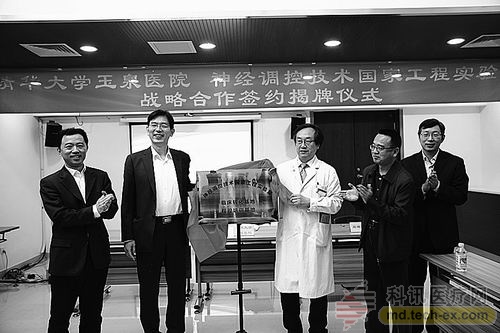Release date: 2016-05-03

The Yuquan Hospital of Tsinghua University and the National Engineering Laboratory of Neuromodulation Technology of the School of Aerospace and Aeronautics, Tsinghua University held a strategic cooperation signing ceremony.
Recently, Yuquan Hospital of Tsinghua University and the National Engineering Laboratory of Neuromodulation Technology of Tsinghua University Aerospace and Aeronautics and Astronautics Institute held a strategic cooperation signing ceremony to promote the clinical transformation and application of neurological regulation technology in the country, and established a national standardized training medium for neuromodulation. It is reported that this cooperation is a research project of "Integration of Industry, Education and Research" in the Department of Clinical Medicine of Tsinghua University, and another successful case of translational medicine at Tsinghua University.
According to reports, neuromodulation is a biomedical engineering technique that uses implantable or non-implantable techniques to alter the activity of the central nervous system, peripheral nerves, or autonomic nervous system to improve the symptoms of patients using electrical stimulation or drugs. It is currently widely used in the treatment of dyskinesia diseases such as Parkinson's disease.
This cooperation is combined with the superior resources of different departments of Tsinghua University to improve the innovation capability and industrialization level of medical devices. The cooperation relies on the neurological control technology of the National Engineering Laboratory and the clinical neurosurgical medical system of Yuquan Hospital of Tsinghua University to develop and innovate in order to establish the “integration of production, study and research†with Tsinghua characteristics.
It is understood that the National Engineering Laboratory of Neuromodulation Technology is hosted by Tsinghua University. It focuses on the treatment of diseases such as Parkinson's disease, epilepsy and depression, and carries out energy transmission optimization and closed-loop for the technical bottleneck of research and development and production of related neuromodulation implanted devices. Technical research and key process tests such as control and electrode reliability have developed a series of neuro-regulatory implant devices with independent intellectual property rights, which makes the product internationally competitive, fills the domestic gap, and breaks the monopoly of American companies in this field. .
After more than ten years of continuous efforts, the National Engineering Laboratory of Neuromodulation Technology has also developed brain pacemakers that are compatible with high field and strong magnetic resonance, record brain deep nuclear eEG, and variable frequency stimulation, and have innovatively built a conformity. The remote program-controlled network of China's national conditions gradually realizes the leap from parallel to leading.
In the past two years, the "brain pacemaker", one of Tsinghua's neuromodulation products, has broken the foreign technology monopoly with high quality and low price, and has realized the leading and surpassing of technology. Compared with similar foreign products, the price has dropped by 40%~50%. Up to now, the patient has saved 200 million yuan in treatment costs. The market share has rapidly increased and it has become an emerging dark horse brand in the medical field. At present, it has been clinically applied in more than 90 hospitals across the country, and more than 3,500 implants have been completed, which has been well received by patients.
At present, Tsinghua Brain Pacemaker also has functions such as external wireless charging, Internet remote adjustment parameters and tracking therapy. The R&D team also used Internet technology to achieve remote control of postoperative patients internationally. Through a specific platform, doctors can use the network and data transmission methods to provide long-term follow-up and follow-up treatment to ensure the patient's postoperative efficacy.
Experts say that medical products are different from Other common industrial products. It requires the cooperation of scientific research, clinical and production units, that is, the integration of production, education and research. The clinical application unit is not only the origin of the project demand, but also the verification and use of scientific research results. Therefore, from the clinical point of view, back to the clinic, it is the biggest difference between medical products and other products.
In addition, the Tsinghua University School of Medicine trains a large number of medical talents every year, so that these medical students are exposed to the latest clinical research results, which is also one of the goals of this cooperation. The clinical medicine professors who participated in the construction of the base will teach the latest research results in the field of neuromodulation to students in the first time, and improve the closeness of medical students' clinical integration.
According to reports, the construction of the "National Engineering Laboratory Clinical Transformation Base and Program Control Training Base for Neuromodulation Technology" will promote cooperation units to learn from each other's strengths, give full play to their respective advantages, accelerate clinical transformation in the field of neuromodulation, and establish postoperative program control in the field of neuromodulation. Standardization.
Source: Chinese Journal of Science
Face Recognition Sensor,Facial Recognitoin System,Access Control Face Recognition,Face Recognition Biometric Machine
GRANDING TECHNOLOGY CO LTD , https://www.grandingsecurity.com